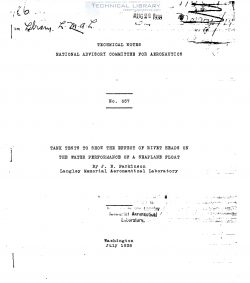naca-tn-657
- Version
- 141 Downloads
- 943.54 KB File Size
- 1 File Count
- November 28, 2016 Create Date
- November 28, 2016 Last Updated
National Advisory Committee for Aeronautics, Technical Notes - Tank Tests to Show the Effect of Rivet Heads on the Water Performance of a Seaplane Float

A l/3.5 full-size model of a seaplane float construct-
ed from lines supplied by the Bureau of Aeronautics, Navy
Department, was tested in the N.A.C.A. tank, first with
smooth painted bottom surfaces and then with round—head
rivets, plate laps. and keel plates fitted to simulate the
actual bottom of a metal float. The percentage increase
in water resistance caused by the added roughness was found
to be from 5 to 20 percent at the hump speed and from 15 to
40 percent at high speeds. The effect of the roughness of
-the afterbody was found to be negligible except at high
trims.
The model data were extrapolated to full size by the
usual method that assumes the forces to vary according to
Froudeis law and, in the case of the smeoth model, by a
method of separation that takes into account the effect of
scale on the frictional resistance. It was concluded that
the effect of rivet heads on the take—off performance of a
relatively high—pOWered float seaplane is of little conse—
quence but that it may be of greater importance in the
case of more moderately powered flying boats.
The resistance of a metal seaplane float or hull on
the water and in the air is increased by rivet heads and
other small excrescences on its surface. In order to Jus-
tify the increased cost of flush riveting, it is desirable
to know the improvement in performance to be expected from
the elimination of projecting heads. Tests of small_models
in the wind tunnel and the towing tank to determine the ex—
tent of this improvement have, in general, been considered
unsatisfactory because of the difficulty in reproducing
the riveted surfaces to scale and the uncertainties due
to scale effects in evaluating.the results.
The increase in the friction coefficient of the sur-
face of a hull in contact with the water has been investi—
gated in the R.A.G.A. tank by testing smooth and riveted
planing surfaces (reference 1). In these tests, full—size
rivet heads were used and the surfaces were towed at the
actual speeds attained in practice. The results, however,
are only generally indicative of the improvement to be
gained by flush riveting because only a part of the re—
sistance during take-off is frictional and the rivet pat—
tern and the flow conditions vary over the float or hull.
A more quantitative investigation must unmefore be made
by tests of models of actual hull forms that are large
enough to minimize difficulties due to scale.
| File | Action |
|---|---|
| naca-tn-657 Tank Tests to Show the Effect of Rivet Heads on the Water Performance of a Seaplane Float.pdf | Download |
Comment On This Post